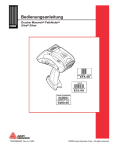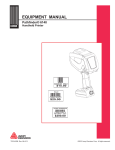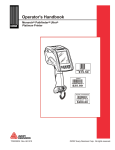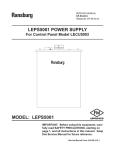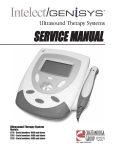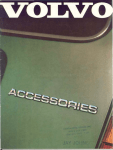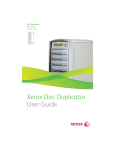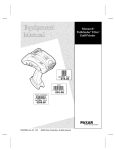Download Avery 6032 Specifications
Transcript
Monarch® Pathfinder® Ultra® Printer TC6032EM Rev. AJ 1/08 ©2007 Paxar Americas, Inc. a subsidiary of Avery Dennison Corp. All rights reserved. Each product and program carries a respective written warranty, the only warranty on which the customer can rely. Paxar reserves the right to make changes in the product and the programs and their availability at any time and without notice. Although Paxar has made every effort to provide complete and accurate information in this manual, Paxar shall not be liable for any omissions or inaccuracies. Any update will be incorporated in a later edition of this manual. ©2007 Paxar Americas, Inc. a subsidiary of Avery Dennison Corp. All rights reserved. No part of this publication may be reproduced, transmitted, stored in a retrieval system, or translated into any language in any form by any means, without the written permission of Paxar Americas, Inc. Trademarks Monarch®, Pathfinder®, Ultra®, Pathfinder® Ultra®, 6032, 9462, and 9465 are registered trademarks of Paxar Americas, Inc. Paxar® is a trademark of Paxar Corporation. Avery Dennison® is a trademark of Avery Dennison Corporation. RBRC® is a trademark of Rechargeable Battery Recycling Corporation. Avery Dennison Printer Systems Division 170 Monarch Lane Miamisburg, OH 45342 TA B L E O F C O N T E N T S INTRODUCTION 1-1 Using This Manual .................................................................................. 1-1 Audience ................................................................................................ 1-1 Getting Started ....................................................................................... 1-2 Helpful Reminders................................................................................... 1-2 Attaching the Safety Strap ....................................................................... 1-3 USING BATTERIES 2-1 Using the Main Battery ............................................................................ 2-1 Changing the Main Battery.................................................................... 2-2 Replacing the Backup Battery .................................................................. 2-3 Main Battery Safety Information................................................................ 2-4 USING SUPPLIES 3-1 Loading Supplies .................................................................................... 3-1 Loading for Peel Mode ......................................................................... 3-3 Loading for Non-Peel Mode .................................................................. 3-6 Removing the Supply Roll in Peel Mode .................................................... 3-6 i ENTERING & PRINTING DATA 4-1 Using the Keypad .................................................................................... 4-1 Data Entry Modes ................................................................................ 4-2 Entering Letters ................................................................................... 4-3 Using the Display .................................................................................... 4-3 Reading the Status Line ....................................................................... 4-3 Scanning Bar Codes ................................................................................ 4-4 Scanner Certification Note ....................................................................... 4-5 Printing .................................................................................................. 4-6 Power Management ................................................................................. 4-6 CARE & MAINTENANCE 5-1 Cleaning ................................................................................................ 5-1 Cleaning the Printhead ......................................................................... 5-2 Cleaning the Platen Roller .................................................................... 5-3 Cleaning the Black Mark Sensor ............................................................ 5-4 Cleaning the Scanner Window ............................................................... 5-4 Cleaning the Scanner Flex Cable .......................................................... 5-5 Clearing Supply Jams .............................................................................. 5-5 Storing the Printer................................................................................... 5-6 TROUBLESHOOTING 6-1 Error Codes ........................................................................................ 6-2 SPECIFICATIONS & ACCESSORIES A-1 Specifications ......................................................................................... A-1 Accessories ............................................................................................ A-2 GLOSSARY ii G-1 1 INTRODUCTION The Monarch® Pathfinder® Ultra® Silver 6032™ printer scans bar codes and prints. Using This Manual Following is a summary of the contents of this manual. Chapter Contents 1 Introduction Information you should know before using the printer. 2 Using Batteries Charging, changing, and using batteries safely. 3 Using Supplies Loading and removing supplies. 4 Entering and Printing Data Using the keypad and scanner, and printing. 5 Care and Maintenance Clearing supply jams and cleaning the printer. 6 Troubleshooting Common problems and their solutions. A Specifications & Accessories Printer specifications and accessories/options. G Glossary Printer terms and their definitions. Audience This manual is for the person who prints and applies labels and scans bar codes. A Quick Reference for this printer is available in the box. A Packet Reference Manual and other documentation are available on our Web site. Information in this document supercedes information in previous versions. Check our Web site (www.paxar.com) for the latest documentation and release information. Introduction 1-1 Getting Started To start using the printer, you must: Review the printer safety information in the Regulatory Compliance document provided with your printer. 2. Charge the battery. See “Charging the Battery” in Chapter 2 for more information. Note: Charge the battery as soon as you receive the printer, even if you do not use it right away. 1. 3. 4. 5. 6. Insert the charged battery in the printer. See “Changing the Battery” in Chapter 2 for more information. Attach the safety strap found in the documentation package. See “Attaching the Safety Strap ” later in this chapter for more information. Load supplies in the printer. See “Loading Supplies” in Chapter 3 for more information. Turn on the printer. Helpful Reminders ♦ Always start with a fully charged battery. ♦ Attach the safety strap to your wrist before using the printer. ♦ Do not pound the printer when applying labels printed in peel mode. ♦ Switch to a fully charged battery every time you load a new roll of supplies. This ensures optimum print quality. ♦ Turn off the printer when you are not using it. ♦ Operate and store the printer within the recommended temperature and humidity ranges. See “Specifications” in Appendix A for more information. 1-2 Equipment Manual Attaching the Safety Strap 1. Turn the printer upside down, resting its top on the table. 2. Take the thin end of the safety strap and push it through the loop at the bottom of the printer handle (near the battery compartment). 3. Push the thick end of the safety strap through the thin end’s loop. 4. Pull the strap. It may be necessary to help the thin end’s loop fit over the plastic piece in the middle of the strap. 5. Pull the strap tight. Introduction 1-3 1-4 Equipment Manual 2 U S I N G B AT T E R I E S The printer uses two batteries: a main battery and a backup battery. Battery Use Main Running the printer. It is also rechargeable using the Monarch 9462 single-station or the Monarch 9465 four-station charger. Backup Maintaining the printer’s system settings. Using the Main Battery The printer’s main power source is a 7.4V lithium-ion battery. Note: The printer only takes this battery. Do not substitute batteries. You must charge the battery when you receive the printer, even if you do not use it right away. Charging the Main Battery To charge the main battery, use either the 9462 single-station or 9465 four-station battery chargers. Refer to the documentation provided with the chargers for more information. Charging time is approximately 1.5 – 3 hours. Warning: The battery might explode if placed on a different charger. Using Batteries 2-1 Changing the Main Battery To change the main battery: 1. Turn the printer over and press the button on the battery compartment door (at the bottom of the printer’s handle) and slide it open. Battery Com partment Door Button 2. Turn the printer upright, holding your palm beneath the open battery compartment. Hit the printer on your hand and catch the battery as it slides out. Batter y 3. Insert a new battery into the compartment (connector end first). 4. Slide the compartment door shut until it clicks into place. 2-2 Equipment Manual Replacing the Backup Battery The backup battery is a 3V lithium coin cell. You can buy additional backup batteries at most stores, part # CR2032. Switch backup batteries when you receive a CMOS error. Cautions: ♦ Risk of explosion if the battery is replaced by an incorrect type! ♦ Dispose or recycle to your local regulations. 1. Remove the main battery. 2. Remove the backup battery by turning it slightly counterclockwise, and pulling it out. Backup Batter y 3. At the same angle, place the new battery (positive side facing away from the main battery) at the edge of the track and under the spring contact. As you push it in, it will straighten itself. The battery should lie flat. 4. Slide the compartment door shut until it clicks into place. Using Batteries 2-3 Main Battery Safety Information ♦ You must charge the battery before using it. For optimal battery life, charge the battery within three months of receipt. ♦ Take the battery out of the printer when storing the printer for a month or longer. ♦ The optimal battery storage temperature is 50°F – 73°F (10°C – 23°C), with a maximum of 104°F (40°C). The battery may lose its charge capacity permanently if stored at temperatures less than 32°F (0°C) or greater than 104°F (40°C). For longest life, the battery should be stored in a cool, dry place. ♦ The operating temperature for the battery is the same as for the printer. See “Specifications” in Appendix A for more information. ♦ The recommended temperature for charging is 68°F – 77°F (20°C – 25°C) ♦ Recycle Information – Do not throw in trash. Recycle to your local regulations. The Rechargeable Battery Recycling Corporation (RBRC ® ) is a non-profit organization created to promote recycling of rechargeable batteries. For more information about how to recycle batteries in your area, visit www.rbrc.org. Batteries can also be returned postage-paid to: ERC; 200 Monarch Lane Door #39; Miamisburg, OH 45342. Caution: Do not disassemble, short-circuit, heat above 80°C, or incinerate the battery. It may explode. ♦ Do not let the battery come into contact with metal objects. ♦ Do not use a battery with a cracked case. ♦ Do not let the battery get wet. ♦ It is normal for battery capacity to decrease up to 20% over the first 300 cycles of use. 2-4 Equipment Manual ♦ The battery should be charged immediately for either long-term storage or after the battery has been exhausted from a printing session. Frequent charging will actually prolong battery life and has no negative effects such as memory issues. ♦ The printer uses battery power even when the printer is not printing. Remove the printer’s battery and place on a charger when the printer is not in use. Many factors affect your battery’s performance, including the quantity of labels printed, intervals of batches printed, percentage of black per label, and power management. Using Batteries 2-5 2-6 Equipment Manual 3 USING SUPPLIES The printer can use three types of supplies: ♦ Labels ♦ Tags ♦ Receipt Paper There are two print modes. The way you load the supplies depends on the print mode you use. ♦ Peel mode removes the backing paper from the supplies as it prints the labels. This mode allows you to apply the label immediately. It is for labels only. ♦ Non-Peel mode does not remove the backing paper. It is for labels printed in a continuous strip, tags, and receipt paper. Loading Supplies To load supplies: 1. Turn on the printer. 2. If a date prompt appears, press Load. Otherwise, choose a format, and then press Load. You see: Load supplies 3. Press the latch buttons and open the supply cover. Co ver Latch Buttons Using Supplies 3-1 4. Pull back the supply lock tab 5. Open the spring-loaded supply holder tabs apart with one hand so it adjusts to the size of your supply roll. You can set it at 1.2”, 1.5”, and 2.0”. Supply Holder 6. Press the supply lock tab down to lock the supply holder in place. 3-2 Equipment Manual 7. Place the supply roll in the supply holder so the supply feeds labels from the bottom. 8. Load the supplies for the printing mode you want. See “Loading for Peel Mode” or “Loading for Non-Peel Mode” for more information. Loading for Peel Mode To load supplies for peel mode: 1. Peel and discard the first four inches of labels from the backing paper. 2. Hold the printer upright and gently press down on the label deflector. It may be stiff. Label Deflector 3. Feed all four inches of the backing paper over the peel bar and under the applicator roller and the label deflector. Using Supplies 3-3 Ap plicator Roller Peel Bar Label Deflector 4. Push the label deflector up until it snaps into place. 5. Partially close the cover to the first position. Partially closed 6. Pull the backing paper over the guide roller, down to the pinch and feed rollers. 3-4 Equipment Manual 7. Hold the backing paper edge between the feed and pinch rollers, and press the trigger. Guide Roller (behind suppl y) Feed Roller (behind Pinch Roller) Pinch Roller 8. Close the cover and press ESC to exit. Using Supplies 3-5 Loading for Non-Peel Mode To load supplies for non-peel mode: 1. Feed the supply under the applicator roller and over the label deflector. Ap plicator Roller Label Deflector 2. Close the cover. 3. Press ESC to exit. Removing the Supply Roll in Peel Mode To remove supplies in peel mode: 1. Tear the backing paper just above the pinch roller. 2. Open the supply cover completely. 3. Spread the supply holder tabs apart with one hand and remove the supply roll. 4. Carefully pull out the supply backing paper still in place between the pinch and feed rollers. 3-6 Equipment Manual E N T E R I N G & P R I N T I N G D ATA 4 This chapter explains the printer’s features and how to use them. Using the Keypad The printer’s keypad appears below. Key(s) Description Enter Accepts data or a menu selection. Ctrl For future use. Alt Displays a special character when you press the key and then enter a 3-digit number. The only character you cannot display is the cent sign (¢). Your System Administrator will tell you what number(s) to use. Tab For future use. Load Begins the supply-loading procedure. Entering & Printing Data 4-1 Key(s) Description Fct Performs a specially-defined function when pressed with a single-digit number. Bksp Moves the cursor one space to the left. Pressing Shift and Bksp together deletes all data on the current line. Shift ♦ Displays a letter shown on the face of a numeric key. See “Entering letters” for more information. ♦ Deletes all data on the current line when pressed with Bksp. Esc Moves to the previous menu or exits the current module/program. Arrows Moves between items in a menu or characters in a line. Sometimes the right arrow may act as a down arrow and the left arrow may act as an up arrow. On/Off Turns the printer on and off. Space Enters a space character. Numeric/ Alphabetic Displays a numeric digit or upper-case letter. . (Decimal point/period) Displays a decimal point or period character. Data Entry Modes There are three data entry modes: ♦ Normal (Numeric) mode – Default. Press the key to access what appears on the face of the key (numbers). ♦ Shift (Alpha) mode – Press Shift to enter letters with number keys or with Bksp to delete the current line. S appears on the status line. ♦ Special Key mode – Press Alt or Fct (with a number) to display a special character or perform a specially-defined function. A or F appears on the status line. 4-2 Equipment Manual Entering Letters To enter uppercase letters, press one of the numeric keys in Shift mode (S appears on the status line). For example, the letters “ABC” appear on the face of the 7 key. 1. Press Shift to enter Shift mode. 2. To enter the letter A, press 7 once; to enter B, press 7 twice; to enter C, press 7 three times. Press the keys quickly. If you pause too long between key presses, the printer assumes you have entered the letter you need and the cursor moves one space to the right. Using the Display The display has three lines: two data lines and one status line. Reading the Status Line The status line has the following indicators: Indicator Description F You have pressed Fct and the printer is in Special Key mode. This mode remains in effect through the next key press. To return to Normal mode without entering a function, press Fct again. A You have pressed Alt and the printer is in Special Key mode. This mode remains in effect until you enter a 3-digit number. To return to Normal mode without entering a number, press Alt again. C For future use. S You have pressed Shift and the printer is in Shift mode. This mode remains in effect until you press Shift again. The printer is in Normal mode when no indicator appears on the display. Entering & Printing Data 4-3 Scanning Bar Codes Your printer may have a built-in scanner. To scan a bar code: 1. Attach the safety strap to your wrist. 2. Point the scanner at a slight angle approximately 4 – 8 inches from the bar code symbol. 3. Press the trigger or other key specified by your System Administrator. Caution: Do not stare into the beam. The scanner LED is at the top left of the keypad, opposite the On/Off key. Scanner LED Description Green Successful scan. Amber Unsuccessful scan. If the bar code does not scan: ♦ Change the scanner’s angle slightly and try again. ♦ Clean the scanner window. See “Cleaning” in Chapter 5 for more information. ♦ Move the scanner 4 – 8 inches away from the bar code. Adjust this distance as needed to find the correct distance. ♦ Try scanning another bar code that you have scanned successfully. If that scan is successful, the scanning problem is with the bar code. ♦ Move to a more dimly lit area. ♦ Ensure there are no voids (streaks) in the bar code symbol. If the scan is still unsuccessful, ask your System Administrator to perform a scanner test. 4-4 Equipment Manual Scanner Certification Note This product is certified to be a Class II laser product with the United States DHHS Center for Devices and Radiological Health and complies with 21CFR1040.10 and 1040.11 except for deviations pursuant to Laser Notice No. 50, dated July 26, 2001. The scanner emits less than 2.0 milliwatt beam of laser light from the scanning window. Laser light in excess of Class I limits must be inside a protective cover. No maintenance is required to keep this product in compliance with EN 60825 and DHHS Regulation 21, Subchapter J. No controls are provided for operation or maintenance. Caution: Use of controls, adjustments or performance of procedures other than those specified herein may result in hazardous laser light exposure. Class II laser scanners use a low power, visible light diode. As with any very bright light source, such as the sun, the user should avoid staring directly into the light beam. Momentary exposure to a Class II laser is not known to be harmful. Entering & Printing Data 4-5 Printing When and how you print depends on your printer’s configuration. It may print ♦ after you press a certain key. ♦ automatically as soon as you press a key. ♦ automatically with no input from you. ♦ one or many labels at once. Power Management The printer goes into sleep mode after a predetermined amount of idle time to conserve power. The printer displays a coffee cup icon when it is in sleep mode. To “wake up” the printer, continue normal use. The printer turns off if it remains in sleep mode for a predetermined amount of time. Your System Administrator sets these time periods. 4-6 Equipment Manual 5 CARE AND MAINTENANCE Caring for and properly maintaining your printer protects it and keeps it running smoothly. This chapter explains how to ♦ clean the printhead, rollers, sensor, and scanner window. ♦ clear supply jams. ♦ store the printer. Cleaning It is important to keep the printer clean. There are five main areas that you must clean: ♦ Printhead ♦ Platen Roller ♦ Pinch and Feed Rollers ♦ Sensor ♦ Scanner ♦ Window ♦ Scanner Flex Cable Do not use sharp objects to clean the printer. Do not use household cleaners to clean the printer. Care and Maintenance 5-1 Cleaning the Printhead Always clean the printhead ♦ after using 7-10 rolls of supplies ♦ in extreme temperatures, humid conditions, or a dirty environment ♦ when you see voids in the print ♦ after a supply jam. Cautions: The following actions may damage the printhead and void your warranty. ♦ Do not use silicone to clean or lubricate. ♦ Do not use sharp objects to remove adhesive or label particles from the printhead area. ♦ Do not touch the printhead with your fingers. To clean the printhead: 1. Turn off the printer. 2. Open the supply cover and remove the supply roll. See “Removing Supplies” in Chapter 3 for more information. 3. Check the supply holder for adhesive buildup and clean it if necessary. 4. Ground yourself by touching a metal object other than the printer. Grounding prevents electrostatic discharge, which may damage your printer. 5. Clean the printhead area of all adhesive and label particles using a Monarch Cleaning Pen (#114226) or a soft cloth moistened with isopropyl alcohol. 6. Reload the supply and close the supply cover. 5-2 Equipment Manual Printhead Cleaning the Platen Roller Clean the platen roller when you see significant adhesive build-up or when a label is wrapped around the platen roller. 1. Turn off the printer and open the supply cover. 2. Remove the supplies. See “Removing Supplies” in Chapter 3 for more information. 3. Hold the printer upright and gently press down on the label deflector. It may be stiff. 4. Use a dry, soft-bristle brush, such as a toothbrush, to clean the platen roller. 5. Turn the platen roller with your finger to clean all the way around. 6. Reload the supplies and close the label deflector and supply cover. Platen Roller If the brush does not remove all the adhesive, moisten a cotton swab with isopropyl alcohol and run the cotton swab across the platen roller. Turn the platen roller with your finger to make sure it is clean all the way around. After cleaning, feed several inches of supply through without printing to remove any remaining isopropyl alcohol. Care and Maintenance 5-3 Cleaning the Pinch and Feed Rollers To clean the pinch and feed rollers: 1. Turn off the printer and open the supply cover. 2. Remove the supplies. See “Removing Supplies” in Chapter 3 for more information. 3. Turn the platen roller with your fingers and run a dry, lint-free cloth across the pinch and feed rollers as they turn. Make sure the rollers are clean all the way around. If that does not work, use a cloth dampened slightly with distilled water. 4. Reload the supplies after the printer dries. Cleaning the Black Mark Sensor To clean the black mark sensor: 1. Turn off the printer and open the supply cover. 2. Remove the supplies. See “Removing Supplies” in Chapter 3 for more information. 3. Clean the black mark sensor with a dry cotton swab. 4. Reload the supplies and close the supply cover. Black Mark Sensor Cleaning the Scanner Window Clean the scanner window whenever it appears to be dirty or smeared. To clean it: 1. Moisten a soft cloth with distilled water. Do not use household cleaners to clean the printer. 2. Wipe the window until it is completely clean. 5-4 Equipment Manual Cleaning the Scanner Flex Cable Occasionally, adhesive buildup appears on the scanner flex cable, as shown. To clean the cable: 1. Turn off the printer and open the supply cover. 2. Clean the cable with 99% isopropyl alcohol and a cotton swab wherever adhesive buildup appears. 3. Close the supply cover. Ad hesi ve Buildup Scanner Flex Cable Clearing Supply Jams To clear a supply jam: 1. Turn off the printer and open the supply cover completely. 2. Open the label deflector by gently pressing down on it with two fingers. 3. Remove the supplies. See “Removing Supplies” in Chapter 3 for more information. 4. Carefully remove any jammed supply and close the deflector. Note: Do not pull the jammed supply out through the front of the label deflector. Do not use sharp objects to remove jammed supplies. 5. Carefully remove any jammed supply between the pinch and feed rollers. 6. Clean any adhesive buildup. 7. Reload the supply and close the label deflector. Feed Roller (behind Pinch Roller) Pinch Roller Care and Maintenance 5-5 Storing the Printer Do not store the printer in or near ♦ magnetic fields ♦ wet or damp areas ♦ dirty or dusty areas ♦ areas of intense vibration or shock. 5-6 Equipment Manual 6 TROUBLESHOOTING Following are some common printer problems and their solutions. Problem Solution Printer does not feed. Switch to a fully-charged battery. Close the supply cover completely. Load the supply correctly. Check the platen roller for jammed labels. Printer does not print. Switch to a fully-charged battery. Load the supply correctly. See “Loading Supply” in Chapter 3 for more information. Clean the printhead. Print has voids or is too light. Load the supply correctly. See “Loading Supply” in Chapter 3 for more information. Close the supply cover completely. Switch to a fully-charged battery. Clean the printhead. See “Cleaning” in Chapter 5 for more information. Check the supply for damage or defects. Printer partially prints on the supply and fails to respond to the keypad or trigger. Load the supply correctly or load new supplies, if necessary. See “Loading Supply” in Chapter 3 for more information. Clear any supply jams. See “Clearing Supply Jams” in Chapter 5 for more information. Clean the printhead. See “Cleaning” in Chapter 5 for more information. Switch to a fully-charged battery. Scanner does not scan a bar code. See “Scanning Bar Codes” in Chapter 4 for more information.. Troubleshooting 6-1 Problem Solution The display does not turn on. Make sure the power is on. Switch to a fully-charged battery. An error code and corresponding message appears on the display. See your System Administrator. Error Codes Following are some common error codes you may receive. Code(s) Description 004 – 005 Supply size is incorrect. Reload the correct supplies. 267 – 271 410 – 413 Communication error. See your System Administrator. 703 – 704 Supply Error. Load supplies or make sure they are loaded correctly. Printhead is overheated. Turn off the printer to let it cool. 750 751 – 753 The printer sensed a problem with a mark on the supplies. Check the supplies to see if they are loaded correctly. 756 The printer is out of supplies. Load supplies. 757 Load supplies. The calibrated supply length differs by plus or minus .25 inches from the format. 758 Supply error. Check for a label jam. Clear the supply path or reload supplies. 762 Low battery. Recharge the battery. 763 Waiting to dispense label. Press Enter. 768 Printhead error. See your System Administrator. 790 – 791 The printer is busy or has an error pending. Turn off the printer. Wait two seconds and turn it back on. 904 – 911 System error. See your System Administrator. SYSTEM ERROR VECTOR ## System error. See your System Administrator. If these solutions do not work or you have a problem or error code not listed, see your System Administrator or call Service at the number listed on the back of this manual 6-2 Equipment Manual A S P E C I F I C AT I O N S & ACCESSORIES Specifications Dimensions: Width – 7.75" (197mm) Length – 3.25" (83mm) Height – 6.50" (165mm) Weight – 1.96 lbs. (.89 kg) Shipping Weight – 5.62 lbs. (2.55 kg) Printhead: 1.89" (48mm/384 dots) (203 dots per inch) Printing: Thermal direct (no ink /ribbon) Print Speed: 2” (51mm) per second Memory: 4MB RAM and 4MB Flash Battery Type: 7.4V Lithium Ion (110V – 240V AC adapter) Battery Recharge Time: 1 – 3 hours, depending on the charger used. Supply Sizes: Width 1.2", 1.5", and 2.0" (30mm, 38mm, and 51mm) Lengths .785" – 4.0" (20mm – 102mm) Peel mode supports .785" (20mm) or greater lengths. Non-Peel mode supports .55" (13.97mm) or greater lengths. Operating Temperature: 40°F – 110°F (4°C – 43°C) Humidity (Operating & Storage): 5% – 90% non-condensing Specifications & Accessories A-1 Accessories This section lists accessories available for your printer and their part numbers. Part Number Description 9462 Single-Station Battery Charger 9465 Four-Station Battery Charger 6063 AC Adapter 114226 Cleaning Pen 120095 Extra Battery 124053 Deluxe Wrist Strap 126791 Petite Wrist Strap 125681 Shoulder Strap M0PHOL0401 Holster/Accessory Pouch/Belt M0PHOL0402 Holster only A-2 Equipment Manual G GLOSSARY Bar code A sequence of vertical black and white bars. The spacing and thickness of these bars is a way of representing data. A scanner reads bar codes. Non-peel mode The print mode that does not remove the backing paper. It is for labels printed in a continuous strip, tags, and receipt paper. Normal mode The default data entry mode. In it, the user presses a key to access what appears on the face of the key. (except letters on the numeric keys). Peel mode The print mode that removes the backing paper from the supplies as it prints the labels. This mode allows you to apply the label immediately. It is only for labels. Platen roller The roller in the printer that the supply is held against. It rotates, helping to move the supply along. Printhead The surface in the printer where the printing occurs. The printhead is composted of many dots. The supply moves across the printhead print the label data. Sensor A device that “sees” that a new label has started. This is done with black marks on the back of the supplies. Shift mode The print mode where the user presses Shift to enter a letter shown on the face of a numeric key. See “Entering Letters” in Chapter 4 for more information. delete all data on the current line when pressed with Bksp. Supplies The labels, tags, or receipt paper printed on. Special key mode The data entry mode after the user presses Fct or Alt and then a number to access functions or display special characters. Glossary G-1 G-2 Equipment Manual Visit www.paxar.com for sales, service, supplies, information, and telephone numbers for our International locations. TOLL FREE: 1-800-543-6650 (In the U.S.A.) 1-800-363-7525 (In Canada)










































